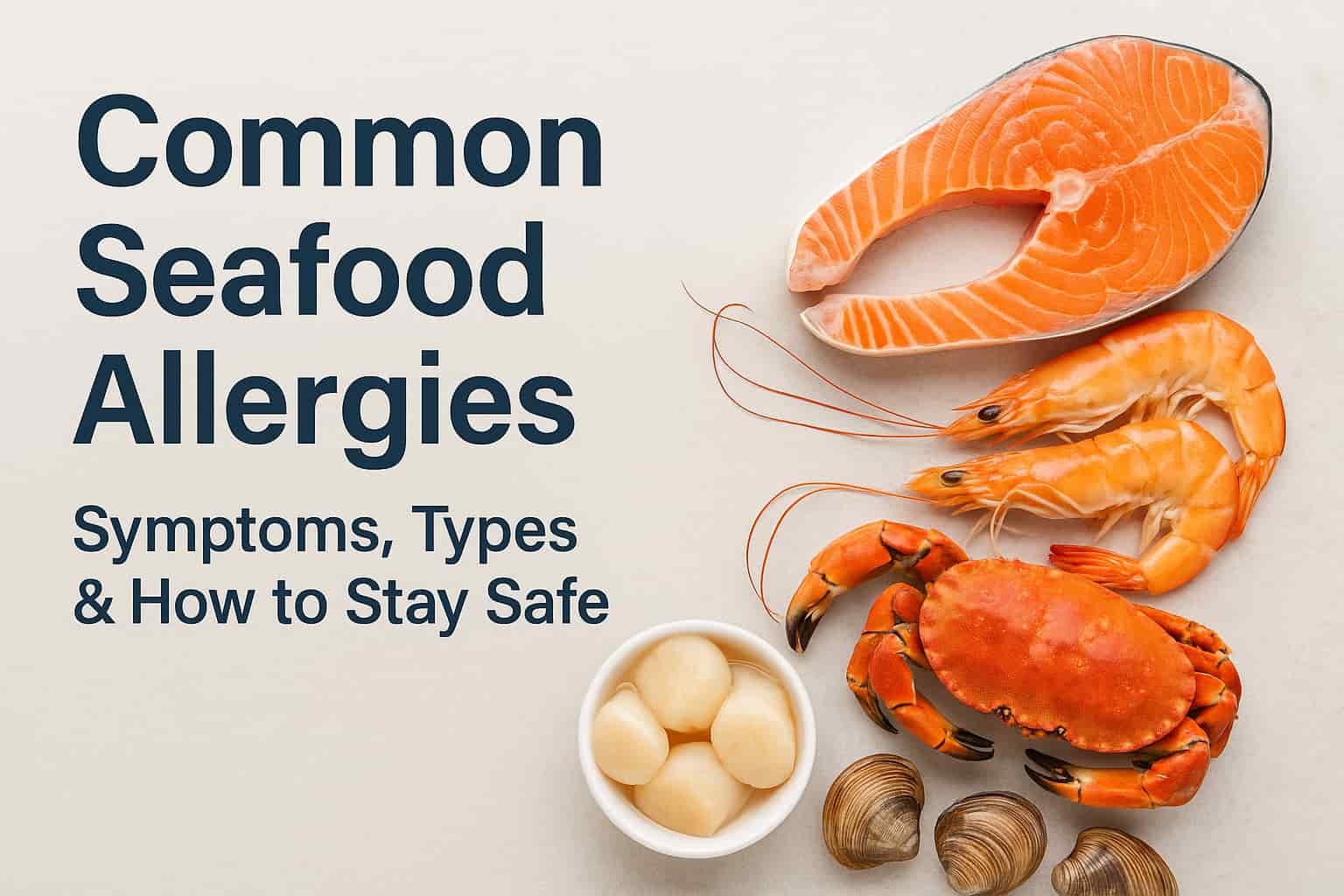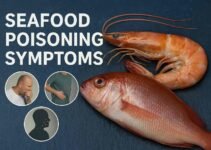Seafood is a staple in diets around the world, offering a rich source of protein, omega-3 fatty acids, and essential nutrients. However, for millions of people, consuming seafood can trigger serious and even life-threatening allergic reactions. Seafood allergies are among the most common food allergies and often persist into adulthood, unlike many other food sensitivities that children may outgrow.
Understanding the causes, symptoms, and risk factors of seafood allergies is essential not just for those who suffer from them but also for caregivers, food service professionals, and health-conscious consumers. Whether you’re navigating dietary restrictions or simply seeking to make safer food choices, this guide provides clear and practical information about common seafood allergies and how to manage them effectively.
Contents
- 1 What Is a Seafood Allergy?
- 2 Shellfish vs. Fish Allergies: What’s the Difference?
- 3 Most Common Seafood Allergens
- 4 Symptoms of Seafood Allergy
- 5 Diagnosis and Testing
- 6 Cross-Contamination and Hidden Seafood Sources
- 7 Treatment and Emergency Preparedness
- 8 Living with a Seafood Allergy
- 9 Conclusion
- 10 Frequently Asked Questions
- 10.1 1. Can you suddenly develop a seafood allergy as an adult?
- 10.2 2. Are shellfish allergies more dangerous than fish allergies?
- 10.3 3. Is it safe to eat at seafood restaurants if I have a seafood allergy?
- 10.4 4. Can seafood allergies go away over time?
- 10.5 5. What’s the difference between food intolerance and a food allergy?
What Is a Seafood Allergy?
A seafood allergy occurs when the body’s immune system mistakenly identifies certain proteins found in seafood as harmful substances. In response, it produces antibodies known as Immunoglobulin E (IgE), which trigger the release of chemicals like histamine during subsequent exposure. This immune response leads to a wide range of allergic symptoms, from mild skin irritation to severe, life-threatening anaphylaxis.
Seafood allergies are typically classified into two categories: fish allergies (such as salmon, tuna, or cod) and shellfish allergies (such as shrimp, crab, or clams). Each category involves different allergens, and being allergic to one does not necessarily mean being allergic to the other—though cross-reactivity can occur.
It’s also important to distinguish a true seafood allergy from food intolerance. While both can cause discomfort, intolerances (such as a sensitivity to histamines in certain fish) do not involve the immune system and are not life-threatening.
Shellfish vs. Fish Allergies: What’s the Difference?
Though they are often grouped together under the term “seafood allergies,” fish and shellfish allergies are biologically distinct. The proteins responsible for triggering allergic reactions differ significantly between finned fish and shellfish, meaning that an individual allergic to salmon may not react to shrimp, and vice versa.
Fish allergies involve finned species like salmon, tuna, cod, and halibut. Shellfish allergies, on the other hand, are divided into two subtypes:
- Crustaceans: shrimp, crab, lobster (most allergenic)
- Mollusks: clams, mussels, scallops, squid, and oysters
Among shellfish, crustaceans tend to be the most common and severe allergens. Studies have shown that crustacean allergy accounts for the majority of shellfish-related anaphylaxis cases. Mollusk allergies are less prevalent and sometimes tolerated by individuals with crustacean allergies, although caution is always advised.
Understanding these differences is critical for proper diagnosis and dietary management. Avoiding all seafood unnecessarily can limit nutritional options, while overlooking cross-reactivity can increase the risk of accidental exposure.
Most Common Seafood Allergens
Seafood allergies can be triggered by a wide range of marine animals, but certain species are far more likely to cause allergic reactions than others. These allergens fall into two primary categories: fin fish and shellfish.
Fin Fish Allergens
Fin fish allergens include species like:
- Salmon
- Tuna
- Cod
- Haddock
- Halibut
Parvalbumin, a heat-stable protein found in the muscle tissue of many fish, is the main allergen responsible for triggering reactions. Because it remains active even after cooking, both raw and cooked fish can provoke symptoms.
Shellfish Allergens
Shellfish is divided into:
- Crustaceans: shrimp, crab, lobster – the most common and severe shellfish allergens
- Mollusks: clams, mussels, oysters, scallops, and squid – less commonly allergenic but still a risk
Tropomyosin is the major allergenic protein in shellfish, and like parvalbumin, it is highly resistant to heat and digestion. Notably, those allergic to one type of shellfish (e.g., shrimp) often react to others due to cross-reactivity.
Because of this, health professionals often recommend avoiding all shellfish if you’re allergic to one type, unless advised otherwise by a specialist after allergy testing.
Symptoms of Seafood Allergy
Seafood allergy symptoms can vary in intensity, ranging from mild discomfort to severe, life-threatening reactions. The onset of symptoms typically occurs within minutes to a few hours after ingestion, inhalation (e.g., steam from cooking), or skin contact.
Mild to Moderate Symptoms
- Itching or tingling in the mouth
- Hives, eczema, or skin redness
- Stomach cramps, nausea, vomiting, or diarrhea
- Nasal congestion or sneezing
Severe Symptoms (Anaphylaxis)
- Swelling of the lips, tongue, or throat
- Difficulty breathing or wheezing
- Rapid drop in blood pressure
- Dizziness or fainting
- Loss of consciousness
Anaphylaxis is a medical emergency that requires immediate administration of epinephrine and emergency care. People with known seafood allergies should always carry an epinephrine auto-injector and have an emergency plan in place.
Recognizing early signs of a reaction and acting quickly can be life-saving. Even if symptoms initially seem mild, they can escalate rapidly in some individuals.
Diagnosis and Testing
If you suspect a seafood allergy, proper diagnosis by a qualified allergist is essential. Self-diagnosis can lead to unnecessary dietary restrictions or missed exposure risks.
Diagnostic Methods Include:
- Skin Prick Test (SPT): A small amount of allergen is introduced into the skin to observe any reaction.
- Blood Test (sIgE): Measures levels of specific IgE antibodies to particular seafood proteins.
- Oral Food Challenge (OFC): Under medical supervision, small amounts of seafood are consumed to monitor for reactions. This is considered the gold standard but is only done in safe, controlled environments.
It’s also important to discuss any family history of allergies, prior reactions, and other atopic conditions (such as asthma or eczema) with your doctor. These factors can influence both diagnosis and management.
Confirming the exact allergen helps in developing a personalized avoidance and treatment plan. In some cases, people may test positive for sensitization but not react clinically, highlighting the importance of expert evaluation.
Cross-Contamination and Hidden Seafood Sources
For people with seafood allergies, avoiding the allergen isn’t just about steering clear of shrimp or tuna on a plate—it’s also about understanding the hidden ways exposure can occur. Cross-contamination and unlabeled ingredients present a serious risk, especially when dining out or consuming packaged foods.
Cross-Contamination Risks
Cross-contact happens when allergenic proteins are transferred from seafood to another food through:
- Shared cooking equipment (grills, fryers, cutting boards)
- Utensils not properly cleaned between uses
- Reused cooking oils, especially in seafood restaurants
Even trace amounts of seafood protein can trigger severe reactions in highly sensitive individuals. That’s why it’s crucial to ask restaurants whether foods are cooked separately from seafood or if a dedicated fryer is used.
Hidden Sources of Seafood
Seafood proteins can be found in unexpected places, such as:
- Sauces and broths: fish sauce, oyster sauce, bouillabaisse, Worcestershire sauce
- Processed foods: imitation crab, seafood-flavored snacks
- Supplements and cosmetics: fish oil capsules, collagen, some skincare products
Always read ingredient labels carefully and call manufacturers when in doubt. When eating out, clearly communicate your allergy to restaurant staff and ask specific questions about food preparation.
Treatment and Emergency Preparedness
Currently, there is no cure for seafood allergies. The primary approach is strict avoidance and being prepared to treat accidental exposures. Managing a seafood allergy requires vigilance and having the right tools at hand in case of an emergency.
First-Line Treatment
- Antihistamines: For mild symptoms such as hives or itching
- Epinephrine (Adrenaline): For severe reactions, especially anaphylaxis. This is administered using an auto-injector like an EpiPen or Auvi-Q and should be followed by immediate medical attention
Emergency Preparedness Tips
- Always carry at least one epinephrine auto-injector if prescribed
- Wear a medical alert bracelet or carry a wallet card indicating your allergy
- Educate friends, family, coworkers, or school staff on how to respond during an allergic reaction
- Create a written action plan in consultation with your doctor
Being prepared can make a life-saving difference. Don’t wait for symptoms to escalate—administer epinephrine promptly if signs of anaphylaxis appear.
Living with a Seafood Allergy
Although living with a seafood allergy presents challenges, many people manage it successfully with planning and awareness. It’s not just about avoiding certain foods—it’s about building a lifestyle that minimizes risk while maintaining quality of life.
Daily Management Strategies
- Read labels thoroughly every time you shop—even on familiar products, as ingredients can change
- Cook at home more frequently to control ingredients and preparation methods
- Choose allergy-aware restaurants and alert the staff before ordering
For Parents and Children
- Teach children to recognize and avoid allergenic foods
- Ensure schools are aware of the allergy and have an emergency plan in place
- Involve kids in meal planning to empower them with knowledge and confidence
Support groups, dietitian consultations, and mobile apps for allergy-friendly dining can also ease the burden. With the right tools, living with a seafood allergy can become manageable rather than restrictive.
Conclusion
Seafood allergies are a serious and often lifelong condition that can significantly impact day-to-day life. Whether you’re allergic to fin fish, shellfish, or both, understanding how to recognize symptoms, avoid exposure, and respond to emergencies is essential to staying safe.
With proper diagnosis and a proactive management plan, individuals with seafood allergies can lead healthy, fulfilling lives. Education, preparation, and clear communication—especially when dining out or trying new products—are the cornerstones of allergy safety.
If you suspect you or someone in your family may have a seafood allergy, consult with a qualified allergist for testing and guidance. And remember: knowledge is not only power—it’s protection.
For more related information, consider reading our in-depth guides:
Frequently Asked Questions
1. Can you suddenly develop a seafood allergy as an adult?
Yes, it is possible to develop a seafood allergy later in life, even if you’ve eaten seafood for years without any issues. Adult-onset seafood allergies are not uncommon and may result in more severe reactions.
2. Are shellfish allergies more dangerous than fish allergies?
Both can be serious, but shellfish allergies—particularly to crustaceans like shrimp and crab—are more commonly associated with severe reactions, including anaphylaxis. Always treat both with equal caution.
3. Is it safe to eat at seafood restaurants if I have a seafood allergy?
It depends on the severity of your allergy and the restaurant’s protocols. Due to high risk of cross-contact, many allergists recommend avoiding seafood-focused establishments unless you have clear communication and trust in the kitchen’s handling procedures.
4. Can seafood allergies go away over time?
Unlike milk or egg allergies that some children outgrow, seafood allergies usually persist into adulthood. However, every case is unique, and periodic testing by an allergist may help track changes over time.
5. What’s the difference between food intolerance and a food allergy?
A food allergy involves the immune system and can cause life-threatening reactions. In contrast, food intolerance (like histamine sensitivity from fish) usually affects digestion and does not trigger an immune response or anaphylaxis.



